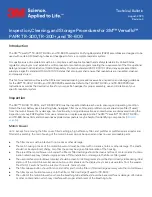
2
3M Personal Safety Division
•
The belt attachment slots (TR-300 and TR-300+) or T-bars (TR-600) on the back of the motor/blower should be intact
and undamaged.
•
Check the airflow using the TR-970 (TR-300) or TR-971 (TR-300+ and TR-600) airflow indicators as described in the
appropriate PAPR User Instructions or in
Technical Data Bulletin #221 – Conducting Airflow Check on the 3M™
•
Check the low airflow alarm by fully covering the airflow outlet as described in the PAPR User Instructions or in
Data Bulletin #221 – Conducting Airflow Check on the 3M™ Versaflo™ PAPR TR-600
Filters and Filter Accessories
•
The filter cover must be intact with no cracks or other damage.
•
The filter or filter/cartridge should be intact with no cracks, tears or other damage. Closely inspect filter/cartridge
plastic housing including the corners and latches, outer rectangular barrier, and inner circular filter seal gasket for cracks,
tears, cuts, distortion, indentations or debris. If the filter or filter/cartridge has been mishandled or dropped, re-inspect
fully. If you have any concerns, contact 3M Technical Service for guidance.
•
If the filter is wet or appears heavily loaded with particulate or damaged, it should be replaced. Never attempt to clean
the filter by any means as intentional manipulation can easily damage the filter media.
•
The high efficiency (HE) filter should be intact with no cracks, tears or other damage noted. If the filter is wet or appears
heavily loaded with particulate, it should be replaced. Never attempt to clean the filter by any means as intentional
manipulation can easily damage the filter media
•
The gasket on HE filter should be firmly attached, clean and intact. There should not be any indentations, tears, rips, or
debris. Replace the filter immediately if any damage is noted.
•
The prefilter (if used) should be intact with no tears or cuts. If the prefilter is wet or appears heavily loaded with partic
-
ulate, it should be replaced. Use of the prefilter and frequent change out may help prolong the life of the HE filter and
help maximize battery pack run time.
•
The metal spark arrestor/prefilter (if used) should be clean and intact with no damage. Frequent cleaning or change out
of the spark arrestor may help prolong the life of the HE filter and help maximize battery pack run time. The spark
arrestor must be used during hot work, molten metal or spark creating operations.
NOTE
: The foam prefilter and the metal spark arrestor/prefilter should not be used simultaneously. Review the TR-300+ PAPR
NIOSH approval label to determine which component is approved for use with your specific system configuration.
Battery Pack
•
Inspect the battery pack for cracks, holes or other damage. The plastic case should not be discolored, chalky, or soft.
These may be signs of deterioration of the battery housing.
•
Battery pack electrical contacts should be clean and dry with no corrosion.
•
Battery pack hinge should be intact with no damage or erosion.
•
Battery pack release button should move freely and function properly.
•
Attach the battery pack to the motor/blower and gently tug on the battery pack to confirm it properly attaches, and the
battery pack is being held firmly in place.
•
When pushing the “Test” button on a fully charged battery pack, on a new battery all five LEDs should light up. On an
aged battery less than five LEDs may light up even if the battery is fully charged. At a certain point the battery may need
to be replaced. For additional battery information, see
Technical Data Bulletin #223 – Battery Maintenance for 3m™
Belt
•
Inspect the belt buckle for damage such as breaks or cracks. Inspect the belt leads for cuts and tears. Inspect the hip
belt for tears and integrity.















